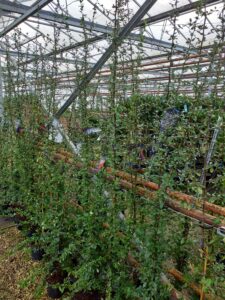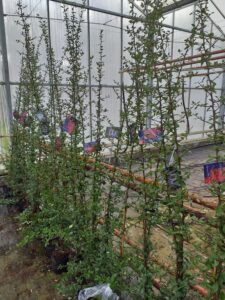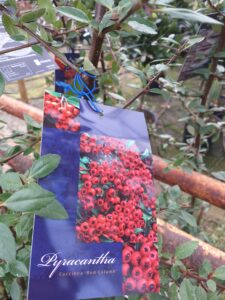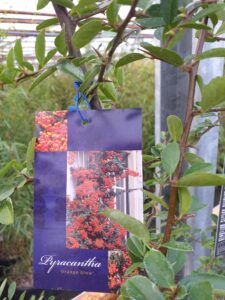Pyracantha

Pyracantha
Pyracantha are a beautiful strong thorny, evergreen shrub. A flowering climber that is low maintenance. White flowers for summer and red, yellow or orange berries in Autumn. We have just received a delivery of Orange Glow and Red Column and they are beautiful, with glossy green foliage and measure up to 2 metres tall. They are perfect for planting near a wall or fence, and make an impenetrable hedge and are great for attracting Wildlife to your garden. Birds like to feed on the berries and nest amongst the evergreen branches, they are easy to grow and tolerant of pollution.Pyracantha Planting tips
Before planting, add a bucketful of well-rotted organic matter or a well balanced general-purpose fertiliser, and then mix with the soil using a fork. Adding organic matter or fertiliser to the bottom of the planting hole is not recommended. If training Pyracantha along a wall or fence, plant at least 50cm out from the wall to avoid the dry area at the base. Allow 1.5–3m (5-10ft) between specimen plants, but 50cm is fine between hedging plants.Pruning Pyracantha
Pyracantha flowers mainly on shoots produced the previous year, so when pruning try to retain as much two-year-old wood as possible. Wear thick gloves when pruning; as its common name (Firethorn) suggests,Pyracantha is incredibly sharp. Prune out shoots badly affected by pyracantha scab. These are easy to spot as the leaves (and often the berries too) will be covered in unsightly black scabs. Pyracantha usually responds reliably to very heavy pruning when overgrown plants need to be renovated.It is more important than ever to do what we can to help the environment.

Planting trees and shrubs, including Pyracantha will make a difference!
Did you know that Bees provide us with every third mouthful of food we eat? Without Bees, we would be unable to grow lots of our favourite foods! Almost any insect that visits flowers can carry out pollination, and therefore classed as a 'pollinator'. Very conservative estimates suggest we have over 1500 pollinating insect species in Britain, though the true figure is likely to be much higher. This includes bees, social and solitary wasps, adult parasitoid wasps, hoverflies and other flies, butterflies and moths and some beetles. Occasionally other insects such as lacewings and some true bugs may also be found on flowers. Bumblebees and solitary bees have specific requirements for nest sites. Many other pollinators such as Hoverflies, butterflies and moth have specific habitat requirements for their larvae. The loss and fragmentation of suitable habitats reduces nesting and breeding opportunities. Gardens can provide suitable breeding places for many pollinators. To see butterflies in your garden, you need to entice them with the right flowers. Adult butterflies feed on nectar that they will take from a wide variety of wild and garden flowers, particularly those growing in warm sheltered places. Butterflies can be encouraged to visit gardens by growing a range of suitable flowers from March, until the frosty weather ends the season in October/November.








